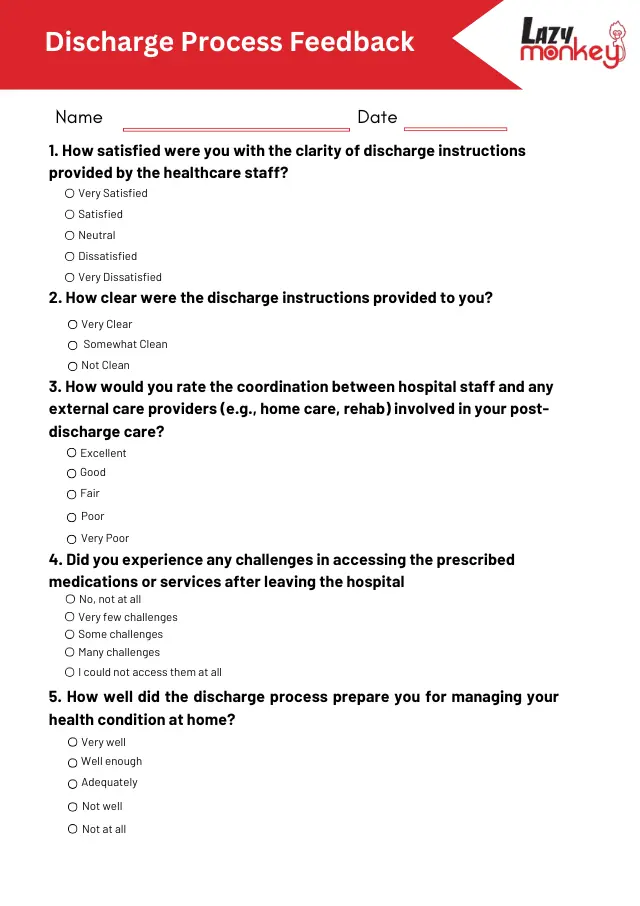
Discharge Process Feedback Template: Optimize Patient Care
The discharge process in healthcare settings is critical to patient outcomes. Ensuring a seamless transition from hospital to home or another care facility requires more than just medical preparation; it involves gathering feedback from patients and families.
The Discharge Process Feedback Template is an essential tool that helps healthcare providers refine their discharge procedures, ensuring patients leave with the confidence and support they need.
Importance of a Discharge Process Feedback Template
A Discharge Process Feedback Template serves as a structured method to collect valuable insights from patients and their families about their discharge experiences.
The feedback gathered through this template not only highlights areas needing improvement but also reinforces the practices that contribute to successful patient transitions.
Template 1.

Template 2.

Why Feedback Matters in the Discharge Process?
Feedback is vital because it offers a real-time perspective on the effectiveness of discharge procedures. It provides direct insights into patient satisfaction, highlighting any gaps in communication, education, or resource allocation.
By implementing a Discharge Process Feedback Template, healthcare facilities can identify and address potential issues before they affect patient outcomes.
Key Components of a Discharge Process Feedback Template
A well-structured Discharge Process Feedback Template should cover all aspects of the patient’s discharge experience. This ensures comprehensive feedback that can be used to improve future processes. Here’s what a robust template might include:
1. Discharge Instructions Clarity
Patients must understand their discharge instructions. Questions here assess how well the medical team communicated the necessary information regarding medications, follow-up appointments, and at-home care.
2. Communication with Healthcare Providers
This section gathers feedback on the quality of communication between the patient and healthcare providers during the discharge process. It evaluates whether patients feel heard and understood, which is crucial for their confidence in managing post-discharge care.
3. Patient Preparedness
The template should ask about the patient’s perceived preparedness for leaving the facility. Did they feel ready? Were they provided with all necessary resources, such as medication or equipment? This feedback can highlight gaps in the discharge planning process.
4. Support System Engagement
Assess whether the patient’s support system (family, friends, caregivers) was involved adequately in the discharge planning. This aspect is vital, especially for patients who rely on others for their post-discharge care.
5. Satisfaction with Overall Experience
Finally, a general satisfaction section allows patients to provide an overall rating of their discharge experience. It’s an opportunity to capture additional comments and suggestions for improvement.
Implementing the Discharge Process Feedback Template
Using a Discharge Process Feedback Template helps collect patient opinions to make healthcare services better. It ensures a smooth discharge and improves patient satisfaction by addressing any issues.
1. Integrate into the Discharge Workflow
For the template to be effective, it needs to be seamlessly integrated into the discharge workflow. This can be achieved by training staff on its importance and incorporating it into their routine tasks.
For example, nurses or case managers can present the feedback form to patients during their final consultation.
2. Ensure Anonymity and Comfort
Patients are more likely to provide honest feedback if they feel their responses are confidential. The template should be designed to assure anonymity and make patients feel comfortable while sharing their experiences.
3. Regular Review and Action
The feedback collected is only valuable if it’s acted upon. Establish a routine for reviewing feedback regularly. This could involve monthly meetings where the data is analyzed, trends are identified, and action plans are created to address any issues.
4. Continuous Improvement
The Discharge Process Feedback Template should not be static. It needs to evolve based on the feedback received and changes in discharge procedures. Regular updates to the template ensure that it remains relevant and effective in capturing the most pertinent information.
Benefits of Using a Discharge Process Feedback Template
Using a discharge process feedback template makes it easy to gather patient feedback, helping hospitals improve discharges and keep patients satisfied.
1. Enhanced Patient Satisfaction
By systematically gathering and acting on feedback, healthcare providers can significantly enhance patient satisfaction. When patients feel heard and see their suggestions implemented, it fosters trust and improves their overall experience.
2. Improved Patient Outcomes
A smooth discharge process leads to better patient outcomes. When patients and their families are well-prepared, the likelihood of complications and readmissions decreases. The feedback template ensures that all necessary information is conveyed clearly and effectively.
3. Streamlined Communication
The Discharge Process Feedback Template can highlight communication barriers that may exist between patients and providers. Addressing these issues can streamline communication, ensuring patients fully understand their care instructions.
4. Compliance with Regulatory Standards
Healthcare facilities are often required to meet specific regulatory standards for patient care and discharge procedures. A well-implemented feedback template helps maintain compliance by ensuring all aspects of patient care are documented and any deficiencies are addressed.
5. Resource Allocation
Feedback can reveal areas where resources are lacking or need to be reallocated. For instance, if multiple patients report not receiving adequate information about their medication, the facility may need to allocate more time or staff to patient education during discharge.
Challenges in Implementing a Discharge Process Feedback Template
Implementing a discharge process feedback template is crucial but challenging. Issues like data accuracy, patient participation, and integration into workflows often arise, making it tough to ensure effective use and meaningful improvements.
1. Patient Participation
One of the most common challenges is ensuring patient participation. Some patients may be unwilling or unable to complete the feedback form due to time constraints, health conditions, or discomfort in sharing negative experiences.
2. Staff Engagement
The success of the Discharge Process Feedback Template depends on staff engagement. If the healthcare team does not prioritize the collection and review of feedback, the process can become ineffective. Training and demonstrating the value of feedback are crucial.
3. Data Management
Handling the feedback data effectively can be challenging. Facilities must establish a system for collecting, analyzing, and storing feedback securely. Additionally, transforming this data into actionable insights requires expertise and resources.
4. Customization for Diverse Patient Needs
Patients have diverse needs and experiences. A one-size-fits-all template may not capture the specific concerns of every patient group. Therefore, customization of the template for different patient demographics (such as elderly patients or those with chronic conditions) is necessary but challenging.
Overcoming Challenges: Best Practices for Feedback Collection
Collecting feedback can be tough, but it’s essential for improvement. This guide shares best practices to overcome common challenges and gather valuable insights effectively.
1. Simplify the Process
Make the feedback form as simple as possible. Use plain language, avoid medical jargon, and limit the number of questions to those that are most essential. This increases the likelihood of patient participation.
2. Offer Multiple Feedback Channels
Providing patients with multiple ways to give feedback (e.g., paper forms, digital surveys, telephone interviews) can increase response rates. Some patients may prefer a quick online survey, while others might find a face-to-face interview more comfortable.
3. Engage with Patients Early
Introduce the idea of feedback early in the discharge planning process. Inform patients and their families that their input is valued and will be used to improve care. This sets the expectation that they will be asked for feedback and may increase their willingness to participate.
4. Train and Support Staff
Healthcare staff should be well-trained in how to present the feedback template to patients. They should understand its importance and be able to answer any questions patients may have about the process.
5. Regularly Update the Template
As healthcare practices and patient needs evolve, so too should the Discharge Process Feedback Template. Regularly review and update the template to ensure it remains relevant and effective in capturing meaningful feedback.
Customizing Your Discharge Process Feedback Template
Every healthcare facility is unique, and so are its patients. Therefore, it’s essential to customize your Discharge Process Feedback Template to meet the specific needs of your patient population.
1. Consider Patient Demographics
Different patient groups may have different needs. For example, older patients may require more detailed explanations of their discharge instructions, while younger patients might prefer digital resources. Tailoring the feedback template to consider these differences can lead to more useful insights.
2. Reflect Cultural Sensitivity
Ensure that your feedback template is culturally sensitive and inclusive. This means using language that is accessible to all patients and considering any cultural factors that may affect their discharge experience.
3. Adapt to Various Discharge Scenarios
Not all discharges are the same. Some patients may be transitioning to home care, while others might be moving to a rehabilitation facility. Customize the template to address the specific challenges and needs associated with different types of discharges.
Conclusion
A Discharge Process Feedback Template is a crucial tool for ensuring a smooth transition for patients leaving a healthcare facility. By systematically collecting and acting on patient feedback, healthcare providers can enhance patient satisfaction, improve outcomes, and streamline their discharge processes.
Challenges in implementation, such as ensuring patient participation and managing feedback data, can be overcome with careful planning and ongoing staff training. Customizing the template to meet the unique needs of your patient population will ensure that the feedback you collect is relevant and actionable.
Frequently Asked Questions?
What is A Discharge Process Feedback Template?
A Discharge Process Feedback Template is a structured form used by healthcare providers to collect feedback from patients and their families about the discharge process. It helps identify areas for improvement and ensures patients feel supported during their transition from the hospital.
Why is Patient Feedback Important in The Discharge Process?
Patient feedback is crucial because it provides direct insights into the effectiveness of discharge procedures. It helps healthcare providers identify gaps in communication and patient education, leading to better patient outcomes and higher satisfaction rates.
How Can We Encourage Patients to Complete The Discharge Process Feedback Template?
Encourage patients by simplifying the feedback form, offering it in multiple formats, and reassuring them of their anonymity. Training staff to emphasize the importance of feedback also helps increase participation.
What Are The Key Components of An Effective Discharge Process Feedback Template?
Key components include questions about the clarity of discharge instructions, communication with healthcare providers, patient preparedness, support system engagement, and overall satisfaction with the discharge experience.
Enhance Patient Care and NABH Compliance with LazyMonkey
LazyMonkey is your all-in-one solution for improving patient care, retaining more patients, and meeting NABH standards. Our powerful QR-based feedback tool enables you to capture real-time insights from patient feedback, discharge surveys, staff and doctor evaluations, and clinical research, while also streamlining inter-departmental communication.
Transform your healthcare facility today - reach out to us at [email protected], or request a demo here!
Elevate Your Restaurant Experience with LazyMonkey
LazyMonkey’s QR-based feedback system helps you gather real-time insights from customers, track satisfaction levels, and enhance the dining experience. Get instant feedback on your menu, service, and ambience, and make data-driven improvements to boost repeat customers and reviews.
Improve your restaurant today – reach out to us at [email protected], or request a demo here!
Empower Student Engagement and Campus Improvement with LazyMonkey
LazyMonkey offers a seamless way to gather student feedback, track satisfaction, and enhance campus life. From course evaluations to dorm feedback, our QR-based solution makes it easy to capture valuable insights and improve student retention.
Upgrade your university experience – contact us at [email protected], or request a demo here!
Streamline Feedback and Drive Performance Across Your Enterprise/Franchise with LazyMonkey
Whether you manage one or multiple locations, LazyMonkey’s QR-based feedback system helps you gather real-time employee and customer feedback. Improve operational efficiency, track satisfaction, and make data-driven decisions to enhance brand consistency and growth.
Transform your franchise today – reach out to us at [email protected], or request a demo here!
Enhance Customer Satisfaction and Service Standards in Banking with LazyMonkey
LazyMonkey empowers banks to capture real-time feedback from clients across branches. Improve customer experience, assess service quality, and ensure regulatory compliance with our QR-based solution, helping you retain clients and meet banking standards.
Elevate your bank’s customer care – contact us at [email protected], or request a demo here!
Boost Customer Engagement and Mall Satisfaction with LazyMonkey
LazyMonkey’s QR-based feedback tool enables you to collect feedback from shoppers, track satisfaction, and enhance the mall experience. Gather insights on store services, cleanliness, and entertainment to create an unmatched customer journey.














